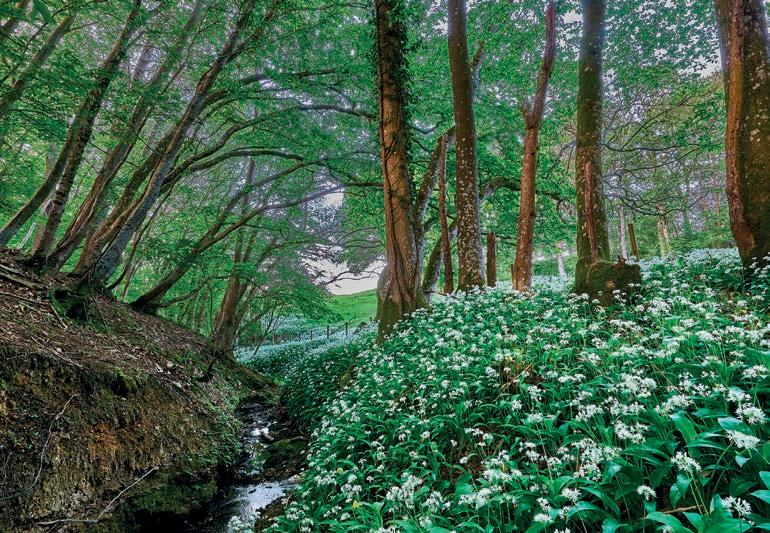
4 minute read
Visual Case Study
CLOSER LOOK:
REDUCING ENVIRONMENTAL IMPACT IN THE COLNE VALLEY
HS2 HAS BEEN CRITICISED FOR ITS ENVIRONMENTAL IMPACTS. BUT AT LEAST ONE APPROACH TO LIMITING – AND MITIGATING – HARM HAS RECEIVED A THUMBS UP FROM ENVIRONMENTALISTS
1Th e environmental eff ects of HS2 are a source of contention. Th e Woodland Trust says phase 1 will directly aff ect more than 32 ancient woodlands and indirectly aff ect another 29 through noise and air pollution. Six have already been felled, according to the trust, and another – Jones’ Hill Wood in Buckinghamshire, which is thought to have inspired Roald Dahl’s Fantastic Mr Fox – is about to lose 1.7 of its 4.4 hectares.
One of the ways HS2’s planners are looking at mitigating this damage is through ‘translocation’ of plants, soils, stumps that can regrow, and dead wood to a nearby location.
2Soil complexity is a defi ning characteristic of ancient woodland. Th ese are woodlands that have existed since at least 1600 and have taken centuries to evolve into our richest terrestrial habitats. Typically, they have developed ecological communities of plants and animals that are not found elsewhere, including many of our threatened species. Once vast, they now cover just 2.5 per cent of the UK. Ancient woodland indicator plants include bluebell, primrose, the wild service tree and herb paris. Click the image to see the Woodland Trust video about ancient woodland.

3In mitigation, HS2 points out that damage will be minimal and that 730,000 new trees have already been planted as part of landscaping that will create 33 square kilometres of new woodland and wildlife habitat en route – a 30 per cent increase over what currently exists. Critics say new planting is no replacement for planting is no replacement for ancient woodland. ancient woodland. 4Th e Woodland Trust has, Trust has, however, given a cautious a cautious thumbs up to the Chiltern he Chiltern Tunnel scheme in the Colne Valley, Colne Valley, which will save nine hectares of ectares of ancient woodland while creating e creating 127 hectares of new grassland, ssland, woodland and wetland. Th e twin-. Th e twinbored 16-kilometre tunnel will carry nel will carry passengers beneath the Chiltern Hills. e Chiltern Hills. Th e scheme will also incorporate the corporate the 3.4km Colne Valley viaduct, Britain’s duct, Britain’s longest railway bridge.
5Two tunnelboring machines – Florence and Cecilia – arrived in the UK last December. At 17 metres long and 2,0000 tonnes each, they will be the largest ever used in the UK and will operate non-stop for three years. As they dig, they’ll line the tunnel with 56,000 concrete wall segments, all made on site.











6Th e tunnelling will produce around three million tonnes of chalk spoil, which will be the foundation for 90 hectares of new chalk grassland, which once thrived on the valley slopes. Th is mitigation scheme has been designed by Align JV, an ecological consultancy set up for the purpose by infrastructure companies Bouygues Construction, Sir Robert McAlpine and VolkerWessels.

7Align has commissioned Cranfi eld University and Tim O’Hare Associates to research the physical and chemical characteristics of the soil profi les that will support resilient, biodiverse grasslands and conduct fi eld trials during construction. “A key challenge with habitat creation is how to establish and then maintain the habitats over the long term,” says Matt Hobbs, ecology lead from Jacobs, on behalf of Align.
Among other features being added to the Colne Valley western slopes are S-shaped sparsely vegetated banks for reptiles and invertebrates, and hibernacula to provide refuges for reptiles and amphibians.



8Lime-rich but low in nutrients, the thin soil of of chalk grassland is poor for for grasses, allowing smaller plants to ts to fl ourish. Th is is a habitat noted for for fl owers such as small scabious and and common bird’s foot trefoil, as well well as rarer plants like the monkey y orchid. It’s also home to beetles es and bees, rare butterfl ies and threatened birds such as the stone one curlew and skylarks, which nest on st on chalk grassland. Th e UK has lost st 80 per cent of its chalk grassland nd since the Second World War. Th e The Colne Valley mitigation scheme goes at least some way to returning this important habitat to one of its native locations.
Click the image above for a twominute video detailing the HS2 tunnel-boring process.



